Charles ‘Frankie’ Rooke
Charles Douglas Willoughby Rooke, known as Frankie to his fellow officers, served with the 1st Battalion The Cameronians (Scottish Rifles) during the First World War. He was killed in action on 19th June 1915, only a couple of weeks before his 21st birthday. Charles is just one of the men immortalised in the fantastic photographs that survive in the regimental collection, a selection of which appear in this article, published on the anniversary of his death.
Charles was commissioned into the 1st Battalion The Cameronians (Scottish Rifles) on 17th September 1913. The Rooke family had a long connection with the British Army, and in particular with the Scots Guards regiment with which several generations of his family had served. Why Charles broke with family tradition and joined The Cameronians is not known, particularly when, as a Roman Catholic, he would be joining a regiment renowned for it’s Protestant origins.
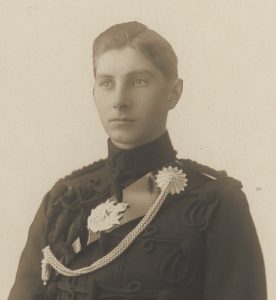
Second Lieutenant Charles D. W. Rooke, most likely taken shortly after his appointment to the Regiment
Charles accompanied the 1st Battalion to France as part of the British Expeditionary Force, arriving in France on August 16th 1914. He was promoted to Lieutenant in late 1914, and served with ‘C’ Company. Captain, later Brigadier-General, James Jack would go on to record in his diary of December 23rd 1914:
“My subalterns, Harry Becher, ‘Frankie’ Rooke and Darrell Hill, have come through all the engagements from Mons without a scratch, or sickness or broken nerves. They are a tough trio of first-class, cool-headed, cheery young officers.”
At the action near La Boutillerie on October 22nd, Captain H. W. Rose, Charles’ Company Commander, was fatally wounded. One of the soldiers who tried to assist the dying officer was Corporal Arthur Honeyball, who was himself badly wounded in the attempt. Corporal Honeyball fortunately survived his wounds, and left an account of that day:
“…when we got to Captain Rose I asked him where he had got it , he said in the back, as soon as he said that, he got another that killed him. I had got hold of him by the feet, and the other chap had got hold of his shoulders, by the time he got the second shot. And then I got mine through the thigh. I must have fainted after that, because when I came to my senses I was in a ditch and no one seemed near me, and I did not know which way to go. The shots were whizzing overhead, and then there was a lull in the firing, so I thought I would look and see if I recognised anything. I then knew which way to go. I was dragging myself along, when I caught sight of a house, so I thought if I could manage to get there I might be alright. So I kept on and it seemed like hours, although the distance was not more than 500 yards from where I was wounded. I got to within 50 yards of the house when I caught sight of some of my regiment in the trenches they had made. When I saw them I said “Thank God”. Mr Rooke, a young Lieutenant, came and helped me up to the house that I was trying to get to, then he called the stretcher bearers and they carried me back to where the doctor was…”

‘Frankie’, centre, holding the hand of a young French girl, with officers and men of ‘C’ Company
Charles was himself wounded on January 5th 1915, while the Battalion were holding the line near the village of Bois Grenier, and sent back to the UK to recuperate. Captain Jack recorded the incident in his diary:
” ‘Frankie’ Rooke was badly wounded this morning by a bullet in the groin. With just a field dressing bandaged on by the company stretcher-bearers, he had to lie in our shelter all day in considerable pain until he could be carried back safely at dusk to the ambulance.”
At the beginning of April 1915, Charles was back in France, having spent a short spell with the 3rd (Special Reserve) Battalion in the north of Scotland. He returned to the 1st Battalion, who were still in the Bois Grenier sector, on April 27th.
During a relatively quiet spell in the trenches in early May, the officers of ‘C’ Company posed for a photograph while enjoying their afternoon tea.
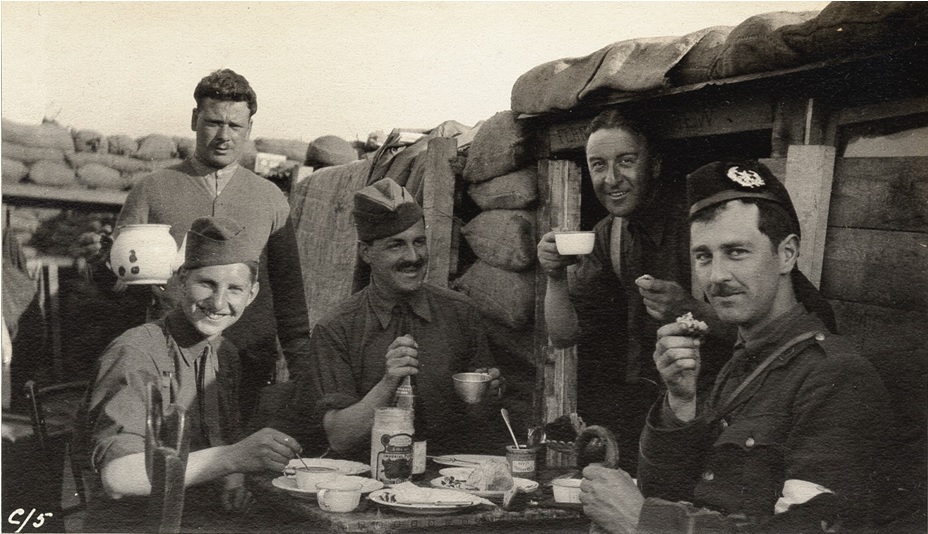
Officers of ‘C’ Company enjoying afternoon tea, 11th May 1915, Bois Grenier sector
The officers are, left to right; Lieutenant Rooke, Lieutenant J. D. Hill, Captain C. C. Scott, and Lieutenant M. N. Gray – the soldier in the background holding the teapot is presently unidentified.
Rooke appears again in another photograph taken on 20th May 1915, this time showing the officers and non commissioned officers of ‘C’ Company in rest billets. Charles is standing second from the right. Only five days earlier he had been slightly wounded in the cheek in an accident involving a grenade. This is one of the last photographs in which Charles appears.
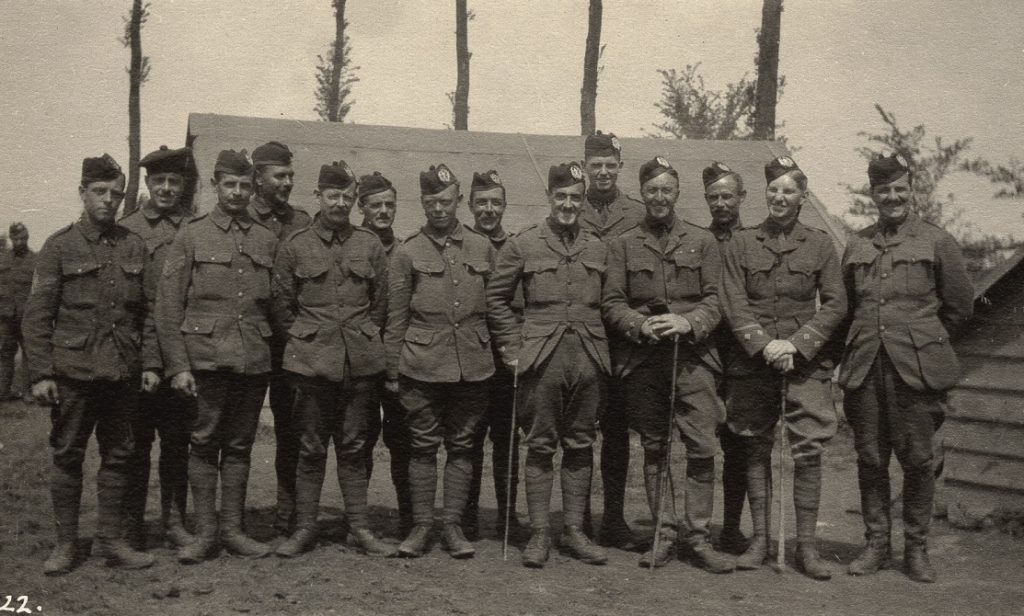
Officers and Non Commissioned Officers, ‘C’ Company, 20th May 1915
On the evening of 19th June 1915, Charles was killed leading a patrol to try and take a German listening post. Major J. G. Chaplin, Commanding Officer of the 1st Battalion The Cameronians (Scottish Rifles) wrote to Charles’ mother, explaining what had happened to her son:
“I am writing to express to you the sincere sympathy of the officers of the Cameronians in the terrible loss which you have suffered. His death is a great blow to the regiment, for he was loved alike by officers and men. He has been so brave and cheery during the whole campaign. I will tell you as well as I can the manner of his death.
The trenches we were occupying were about 300 yards from those of the Germans. On the 19th your boy went out with a patrol of six men to try and capture or destroy a German ‘listening post,’ which was about 100 yards in front of their trenches. The patrol approached the German lines by a ditch which ran from our trenches to theirs. When they were close to the ‘listening post’ the patrol got out of the ditch and spread out on either side, your boy being in the centre close to the ditch, and Private Roberts, who carried bombs, was close to him. They saw some Germans about ten yards from them, and your boy fired four shots with a rifle, and ordered Roberts to throw bombs. Roberts threw two, one of which exploded amongst the Germans. The Germans opened a heavy fire, and Roberts and your boy sprang into the ditch, and the rest of the patrol did the same, and retired a little. Roberts found that your boy was hit and tried to carry him back, but could not do so, so he went back and told the other men – one of them went back and informed Captain Scott of what had happened. Captain Scott sent out Gray, another Subaltern of the Company, who, with the assistance of two other men, most gallantly brought in your boy. The doctor examined him, but he was quite dead, shot through the heart, and death must have been instantaneous – quite painless.
We buried him yesterday afternoon in Bois Grenier, beside Stirling, Becher (his Captain of ‘C’ Company), and Wedderburn. General Robertson attended the funeral, which was conducted by Father MacShane.”
In a tragic twist, Lieutenant Magnus Gray, who had helped bring Charles back to the British line, was shot in the head by a sniper the next day, and died on 21st June 1915. Major Chaplin continued in his letter:
“Poor Gray, who brought in your boy, was killed himself yesterday by a sniper. He asked that if he should be killed that he might be buried beside your boy, and we are doing so.”
If you visit Brewery Orchard Cemetery in Bois Grenier today, you will find the graves of Captain James Stirling, Lieutenant Robert Wedderburn, Captain Henry Becher, and Lieutenants Charles Rooke and Magnus Gray, all of the 1st Battalion Cameronians, buried side by side in a little plot towards the rear of the cemetery. They were among the first to be buried there, the cemetery growing around them as the War wore on. Today the cemetery contains 339 Commonwealth burials from the First World War.
Comments: 1
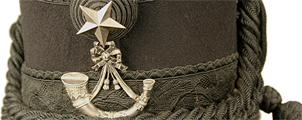
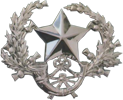

Lieut Rooke was Posthumously awarded a Mention in Despatches for his role in Leading the patrol to attack the German Observation post on 19/06/15. His award appearing in General French’s Despatch of 15/10/15.(London Gazette 31/12/15).
11126 Pte. P.E.Roberts was awarded the
Distinguished Conduct Medal “For conspicuous gallantry on many occasions throughout the campaign, whilst on patrol duty. On the night 19/06/1915, near Armentieres, he endeavoured, under very close-range rifle fire, to rescue a wounded Officer (Lt.Rooke), and, being unable to carry the Officer, procured assistance and brought him into safety. The enemy were only 20yards distant and in strong force.” (London Gazette 05/8/15.) Interestingly he was declared a deserter on 01/01/1916, but it seems returned to the Regiment – as his medals were not forfeited. He survived the War.
Lieut Gray was also awarded a Mention in French’s Despatch 15/10/15 for the search and recovery of the wounded Lieut Rooke.